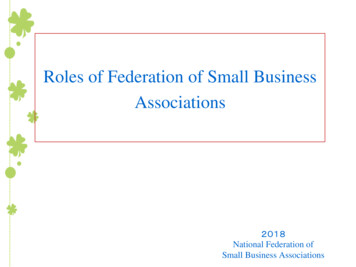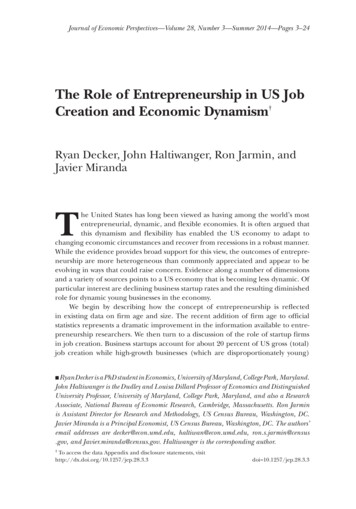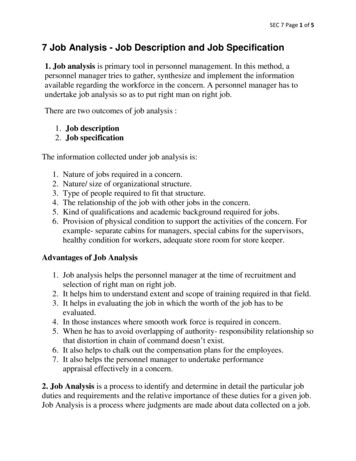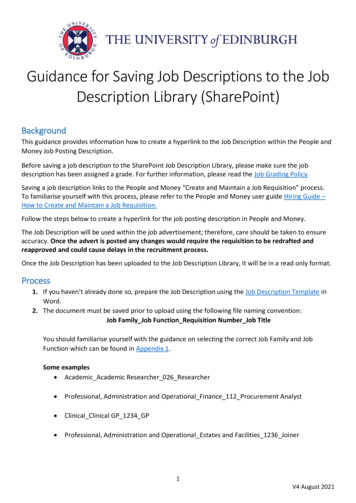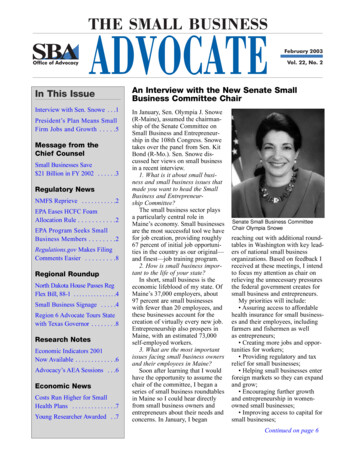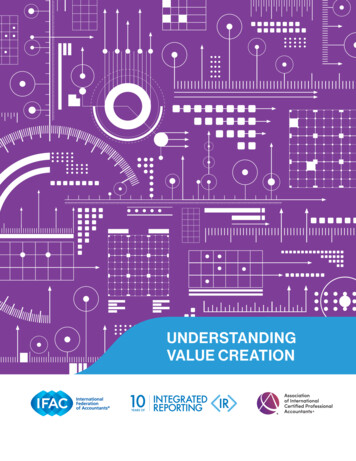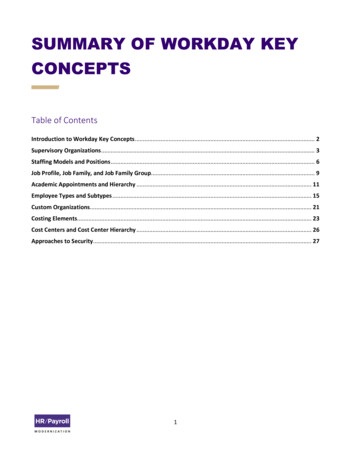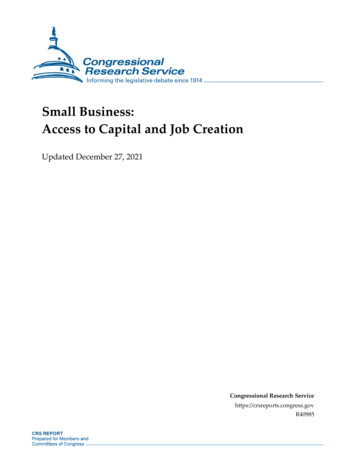
Transcription
Small Business:Access to Capital and Job CreationUpdated December 27, 2021Congressional Research Servicehttps://crsreports.congress.govR40985
Small Business: Access to Capital and Job CreationSummaryThe U.S. Small Business Administration (SBA) administers several programs to support smallbusinesses, including loan guaranty and venture capital programs to enhance small businessaccess to capital; contracting programs to increase small business opportunities in federalcontracting; direct loan programs for businesses, homeowners, and renters to assist their recoveryfrom natural disasters; and small business management and technical assistance training programsto assist business formation and expansion.Congressional interest in these programs has always been high, primarily because smallbusinesses are viewed as a means to stimulate economic activity and create jobs, but it hasbecome especially acute in the wake of the Coronavirus Disease 2019 (COVID-19) pandemic’swidespread adverse economic impact on the national economy.This report provides a brief description of the SBA’s access to capital programs and includescongressional action to assist small businesses during and immediately following the GreatRecession (2007-2009) and during the COVID-19 pandemic, including the following: P.L. 111-5, the American Recovery and Reinvestment Act of 2009 (ARRA),provided the SBA an additional 730 million, including 375 million totemporarily subsidize SBA fees and increase the 7(a) loan guaranty program’smaximum loan guaranty percentage to 90%.P.L. 111-240, the Small Business Jobs Act of 2010, authorized numerous changesto the SBA’s loan guaranty and contracting programs; provided 510 million tocontinue the SBA’s fee subsidies and 90% maximum loan guaranty percentagethrough December 31, 2010; and provided about 12 billion in tax relief forsmall businesses.P.L. 116-136, the Coronavirus Aid, Relief, and Economic Security Act (CARESAct), among other provisions, created a new 349 billion (later increased to 813.7 billion) Paycheck Protection Program (PPP) to provide forgivable, lowinterest loans to assist small businesses, small 501(c)(3) nonprofit organizations,and small 501(c)(19) veterans organizations that have been adversely affected byCOVID-19. The loans were originally available through June 30, 2020, and werelater made available through May 31, 2021.When the national economy is doing well, congressional debate typically involves the extent towhich the federal government should provide the SBA additional resources to assist smallbusinesses in acquiring capital necessary to start, continue, or expand operations and create jobs.Those opposing providing additional resources typically worry about the long-term adverseeconomic effects of spending programs that increase the federal deficit. They generally advocatebusiness tax reduction, reform of financial credit market regulation, and federal fiscal restraint asthe best means to assist small business economic growth and job creation.During and immediately following recessions, concerns about fiscal constraint are typicallysuperseded by the perceived need to help small businesses access the capital necessary to createor retain jobs. During these times of economic distress, congressional debate tends to focus onfinding the means to provide additional SBA assistance to small businesses as quickly andefficiently as possible.This report addresses a core issue facing the 117th Congress: What, if any, additional actionshould the federal government take to enhance small business access to capital?Congressional Research Service
Small Business: Access to Capital and Job CreationContentsSmall Business Access to Capital . 1The Supply and Demand for Private-Sector Small Business Loans. 4Federal Reserve Board: Surveys of Senior Loan Officers . 4SBA Lending . 5Laws Designed to Enhance the Supply of Small Business Loans . 8Laws Designed to Enhance the Demand for Small Business Loans . 13Discussion . 15SBA Funding . 17Concluding Observations . 19FiguresFigure 1. Small Business Lending Environment, 2007-2021 . 5TablesTable 1. Selected Small Business Administration Financial Statistics, FY2007-FY2021. 6Table 2. Small Business Administration Appropriations, FY2005-FY2022 . 18Table A-1. Selected Provisions, the Small Business Jobs Act of 2010. 21Table A-2. Selected Provisions, the Coronavirus Aid, Relief, and Economic Security Act(CARES Act) as amended . 24AppendixesAppendix. Selected Provisions in the Small Business Jobs Act of 2010 and the CARESAct . 21ContactsAuthor Information. 25Congressional Research Service
Small Business: Access to Capital and Job CreationSmall Business Access to CapitalOne of the primary reasons the Small Business Administration (SBA) was created in 1953 was“to preserve free competitive enterprise” by assisting small businesses and, by doing so, preventlarge businesses from forming oligarchies and monopolies that can control the supply of goodsand services and the prices paid for those goods and services. The idea was that the preservationand expansion of full and free competition “is basic not only to the economic well-being but tothe security of this Nation.”1 The perceived by-product of full and free competition was a moreefficient and robust economy that creates and retains jobs.To achieve these goals, the SBA administers several programs to support small businessesneeding access to capital, including venture capital programs to provide “long-term loans andequity capital to small businesses, especially those with potential for substantial job growth andeconomic impact”2 and loan guaranty programs to encourage lenders to provide loans to smallbusinesses “that might not otherwise obtain financing on reasonable terms and conditions.”3Three of the most used SBA business loan programs are the 7(a) loan guarantee program (loans totaling 36.8 billion in FY2021),4the 504/CDC loan guarantee program (loans totaling 8.3 billion in FY2021),5andthe Microloan direct lending program (loans totaling 49.5 million in FY2021 toMicroloan intermediaries and 74.6 million from the Microloan intermediaries toMicroloan borrowers).6In addition, the SBA’s Paycheck Protection Program (PPP) accepted applications—with someinterruptions—from April 3, 2020, through August 8, 2020, and then from January 11, 2021,through May 31, 2021. The SBA approved about 800 billion in PPP loans to assist smallbusinesses negatively affected by the Coronavirus Disease 2019 (COVID-19) pandemic. Underspecified conditions (e.g., at least 60% of the loan proceeds must be used for payroll), these loansmay be forgiven by the SBA.7Historically, one of the justifications presented for funding the SBA’s access to capital programs,other than promoting a full and free competitive economic system, has been that small businesses115 U.S.C. §631.U.S. Small Business Administration (SBA), Fiscal Year 2014 Congressional Budget Justification and FY2012 AnnualPerformance Report, p. 58, at 8-Compliant-FY-2014CBJ%20FY%202012%20APR.pdf.3SBA, Fiscal Year 2010 Congressional Budget Justification, p. 30, at ticle/Congressional Budget Justification 2010.pdf.4 For additional information and analysis concerning the 7(a) loan guarantee program and its subcomponents (such asthe SBAExpress, Community Advantage Loan, and International Loan programs), see CRS Report R41146, SmallBusiness Administration 7(a) Loan Guaranty Program, by Robert Jay Dilger.5 For additional information and analysis concerning the 504/CDC loan guarantee program, see CRS Report R41184,Small Business Administration 504/CDC Loan Guaranty Program, by Robert Jay Dilger.6 For additional information and analysis concerning the Microloan program, see CRS Report R41057, Small BusinessAdministration Microloan Program, by Robert Jay Dilger.7 For additional information and analysis of the Paycheck Protection Program (PPP), see CRS Report R46284, COVID19 Relief Assistance to Small Businesses: Issues and Policy Options, by Robert Jay Dilger and Bruce R. Lindsay.2Congressional Research Service1
Small Business: Access to Capital and Job Creationcan be at a disadvantage, compared with other businesses, when trying to obtain sufficient capitaland credit.8 As an economist explainedGrowing firms need resources, but many small firms may have a hard time obtaining loansbecause they are young and have little credit history. Lenders may also be reluctant to lendto small firms with innovative products because it might be difficult to collect enoughreliable information to correctly estimate the risk for such products. If it’s true that thelending process leaves worthy projects unfunded, some suggest that it would be good tofix this “market failure” with government programs aimed at improving small businesses’access to credit.9Congressional interest in the SBA’s programs has always been high, primarily because smallbusinesses are viewed as a means to stimulate economic activity and create jobs, but it hasbecome especially acute in the wake of the Coronavirus Disease 2019 (COVID-19) pandemic’swidespread adverse economic impact on the national economy.10Economists generally do not view job creation as a justification for providing federal assistance tosmall businesses. They argue that in the long term such assistance will likely reallocate jobswithin the economy, not increase them. In their view, jobs arise primarily from the size of thelabor force, which depends largely on population, demographics, and factors that affect the choiceof home versus market production (e.g., the entry of women in the workforce). However,economic theory does suggest that increased federal spending may result in additional jobs in theshort term.For example, the SBA reported in September 2010 that the 730 million in additional fundingprovided to the agency by P.L. 111-5, the American Recovery and Reinvestment Act of 2009(ARRA), created or retained 785,955 jobs.11 Also, a study by economists at the MassachusettsInstitute of Technology found that the SBA’s Paycheck Protection Program (PPP), created by P.L.116-136, the Coronavirus Aid, Relief, and Economic Security Act (CARES Act), “increasedaggregate U.S. employment by 1.4 million to 3.2 million jobs through the first week of June2020.”12 Perhaps indicative of the methodological challenges in determining PPP’s impact onemployment, other estimates range from a self-reported high of 51 million jobs saved by PPPrecipients to a positive, but imprecise effect on employment by economists at the National Bureauof Economic Research.13Proponents of providing federal funding for the SBA’s loan guarantee programs also argue that small business canpromote competitive markets. See P.L. 83-163, §2(a), as amended; and 15 U.S.C. §631a.9 Veronique de Rugy, Why the Small Business Administration’s Loan Programs Should Be Abolished, AmericanEnterprise Institute for Public Policy Research, AEI Working Paper #126, April 13, 2006, at 414 wp126.pdf. Also, see U.S. Government Accountability Office, Small BusinessAdministration: 7(a) Loan Program Needs Additional Performance Measures, GAO-08-226T, November 1, 2007, pp.3, 9-11, at http://www.gao.gov/new.items/d08226t.pdf.10 For further information and analysis concerning the role of small businesses in job creation, see CRS Report R41523,Small Business Administration and Job Creation, by Robert Jay Dilger. For further information and analysisconcerning programs enacted to assist small businesses during the Coronavirus Disease 2019 (COVID-19) pandemic,see CRS Report R46284, COVID-19 Relief Assistance to Small Businesses: Issues and Policy Options, by Robert JayDilger, Bruce R. Lindsay, and Sean Lowry.11 SBA, “FY2009/2010 Final—Recovery Program Performance Report, September 2010,” September 2010, perform report 9 2010.pdf.12 David Autor, David Cho, Leland D. Crane, Mita Goldar, Byron Lutz, Joshua Montes, William B. Peterman, DavidRatner, Daniel Villar and Ahu Yildirmaz, “An Evaluation of the Paycheck Protection Program Using AdministrativePayroll Microdata,” July 22, 2020, pp. 3, 4, at http://economics.mit.edu/files/20094.13 Ashley D. Bell, SBA southeast regional administrator, “PPP Save Over 51 Million Jobs,” at https://www.sba.gov/8Congressional Research Service2
Small Business: Access to Capital and Job CreationDuring good economic times, congressional debate about the SBA typically involves the extent towhich the federal government should provide the SBA additional resources to assist smallbusinesses in acquiring capital necessary to start, continue, or expand operations and create jobs.Those opposing providing additional resources to the SBA typically worry about the long-termadverse economic effects of spending programs that increase the federal deficit. They generallyadvocate business tax reduction, reform of financial credit market regulation, and federal fiscalrestraint as the best means to assist small business economic growth and job creation.14During and immediately following recessions, concerns about fiscal constraint are typicallysuperseded by the perceived need to help small businesses access the capital necessary to createor retain jobs. During these times of economic distress, congressional debate tends to focus onfinding ways to provide additional SBA assistance to small businesses as quickly and efficientlyas possible. For example, the SBA, which normally is appropriated somewhat less than 1 billionannually, received supplemental appropriations totaling 760.9 billion in FY2020 and 378.5billion in FY2021 to assist small businesses adversely affected by the COVID-19 pandemic.15When determining how to best help small businesses access capital, Congress has recognized thatthe small business lending environment has two key features: the willingness of lenders to offerloans (the supply) and the willingness of small businesses to seek loans (the demand). Forexample, during economic downturns, lenders tend to tighten loan underwriting standards (e.g.,the minimum requirements concerning the applicant’s credit history, the extent of availablecollateral, the business’s past and projected cash flow, and the extent of the owner’s previousbusiness experience) in anticipation that the risk of small businesses defaulting on loans willincrease during recessionary times. This reduces the supply of small business loans. The demandfor small business loans also tends to fall during recessionary times because many small businessborrowers worry about their ability to repay new loans, particularly if the business’s revenue is indecline.Congress also recognizes that there are different ways to address small business loan supply anddemand issues. For example, temporarily increasing SBA loan guaranty percentages encourageslenders to offer (supply) small business loans because the higher guaranty percentages shiftlending risk from the lender to the federal government (the taxpayer). In contrast, temporarilyproviding SBA fee waivers encourages small business borrowers to seek (demand) new loansbecause the cost of securing SBA loans is reduced.This report addresses a core issue facing the 117th Congress: What, if any, additional actionshould the federal government take to enhance small business access to capital? It provides anassessment of the supply and demand for small business loans, and discusses recently -advisories/ppp-save-over-51-million-jobs; SBA, “Paycheck ProtectionProgram (PPP) Report, Approvals through 06/30/2020,” p. 4, at P%20Results%20-%20Sunday%20FINAL.pdf; and Alexander W. Bartik, Zoe B. Cullen, Edward L. Glaeser,Michael Luca, Christopher T. Stanton, and Adi Sunderam, “The Targeting and Impact of Paycheck Protection ProgramLoans to Small Businesses,” National Bureau of Economic Research, Working Paper 27623, July 2020, p. 3, athttps://www.nber.org/papers/w27623.14 See Susan Eckerly, “NFIB Responds to President’s Small Business Lending Initiatives,” Washington, DC, October21, 2009; and National Federation of Independent Business (NFIB), “Government Spending,” Washington, DC, egovernment-should-too-49051/.15 For additional information and analysis of the SBA’s budget, see CRS Report R43846, Small BusinessAdministration (SBA) Funding: Overview and Recent Trends, by Robert Jay Dilger.Congressional Research Service3
Small Business: Access to Capital and Job Creationlaws designed to enhance small business access to capital by increasing the supply of smallbusiness loans, the demand for small business loans, or both.The Supply and Demand for Private-SectorSmall Business LoansFederal Reserve Board: Surveys of Senior Loan OfficersFor many years, the SBA’s Office of Advocacy’s economists have used the Federal ReserveBoard’s quarterly survey of senior loan officers to assess the supply and demand of the smallbusiness lending environment.16 The survey includes a question concerning the senior loanofficer’s bank’s credit standards for small business loans: “Over the past three months, how haveyour bank’s credit standards for approving applications for C&I [commercial and industrial] loansor credit lines—other than those to be used to finance mergers and acquisitions—for small firms(annual sales of less than 50 million) changed?” The senior loan officers are asked to indicate iftheir bank’s credit standards have “Tightened considerably,” “Tightened somewhat,” “Remainedbasically unchanged,” “Eased somewhat,” or “Eased considerably.” Subtracting the percentage ofrespondents reporting “Eased somewhat” and “Eased considerably” from the percentage ofrespondents reporting “Tightened considerably” and “Tightened somewhat” provides anindication of the market’s supply of small business loans.As shown in Figure 1, senior loan officers reported that they generally tightened their smallbusiness loan credit standards from 2008 through late 2009, generally eased their loan creditstandards, with some relatively brief periods of tightening, from 2010 through 2019, andtightened their loan credit standards in 2020 and early 2021, primarily due to the COVID-19pandemic’s widespread adverse economic impact on the national economy. Since then, seniorloan officers have reported that they had eased their loan credit standards somewhat.The survey also includes a question concerning the demand for small business loans: “Apart fromnormal seasonal variation, how has demand for C&I loans changed over the past three months forsmall firms (annual sales of less than 50 million)?” Senior loan officers are asked to indicate ifdemand was “Substantially stronger,” “Moderately stronger,” “About the same,” “Moderatelyweaker,” or “Substantially weaker.” Subtracting the percentage of respondents reporting“Moderately weaker” and “Substantially weaker” from the percentage of respondents reporting“Substantially stronger” and “Moderately stronger” indicates the market’s demand for smallbusiness loans.As shown in Figure 1, senior loan officers reported that the demand for small business loansdeclined somewhat in 2008, and declined significantly in 2009. Demand then leveled off (at arelatively reduced level) during 2010, generally increased, with some relatively brief periods ofdecline, from 2011 through 2019, and generally decreased in 2020 and early 2021, primarily dueto the COVID-19 pandemic’s widespread adverse economic impact on the national economy.Since then, senior loan officers have reported that small business demand had increased modestly.SBA, Office of Advocacy, “Small Business Economic Bulletin: November 2021,” at ssional Research Service4
Small Business: Access to Capital and Job CreationFigure 1. Small Business Lending Environment, 2007-2021(senior loan officers’ survey responses)Source: Federal Reserve Board, “Senior Loan Officer Opinion Survey on Bank Lending Practices,” athttps://www.federalreserve.gov/data/sloos.htm; and Brian Headd, “Forum Seeks Solutions To Thaw Frozen SmallBusiness Credit,” The Small Business Advocate, vol. 28, no. 10 (December 2009), p. 3, at SBA LendingTable 1 shows selected financial statistics for the SBA from FY2007 to FY2021. It provides anoverview of the extent of the SBA’s various programs to enhance small business access to capital.The first column reports the total amount of SBA-approved 7(a) loans, 504/CDC loans, and loansto Microloan intermediaries from FY2007 to FY2021. Each year, 7% to 10% of 7(a) and504/CDC approved loans are subsequently canceled for a variety of reasons, typically by theborrower (e.g., the borrower found funding elsewhere, sold the business, etc.).The second column indicates the net amount, after cancellations and returns, of SBA-approvedPaycheck Protection Program (PPP) loans in FY2020 and FY2021. PPP lending volume wasunprecedented. Largely due to the PPP, the SBA’s total lending amount in FY2020 exceeded thetotal amount provided from all of the SBA’s lending programs combined over the previous 29years.The third column reports the contract value of bonds guaranteed under the SBA’s surety bondguarantee program.17 A surety bond is a three-party instrument between a surety (someone whoagrees to be responsible for the debt or obligation of another), a contractor, and a project owner.For further information and analysis of the SBA’s surety bond guarantee program, see CRS Report R42037, SBASurety Bond Guarantee Program, by Robert Jay Dilger.17Congressional Research Service5
Small Business: Access to Capital and Job CreationThe agreement binds the contractor to comply with the contract’s terms and conditions. If thecontractor is unable to successfully perform the contract, the surety assumes the contractor’sresponsibilities and ensures that the project is completed. It is designed to reduce the risk ofcontracting with small businesses that may not have the credit history or prior experience oflarger businesses. The SBA does not issue surety bonds. Instead, it provides and manages suretybond guarantees for qualified small and emerging businesses through its Surety Bond Guarantee(SBG) Program. The SBA reimburses a participating surety (within specified limits) for lossesincurred due to a contractor’s default on a bond.18Table 1. Selected Small Business Administration Financial Statistics, FY2007-FY2021(millions of )FiscalYear7(a),504/CDC, am NetAmountApprovedb2021 45,203 277,700 6,800 36,300 713,1962020 28,816 525,012 7,190 33,700 835,9962019 28,676— 6,480 33,900 143,5162018 30,668— 6,490 33,400 141,7192017 30,977— 6,031 32,400 131,4832016 29,374— 5,724 28,200 124,0112015 28,327— 6,348 25,200 118,7672014 23,764— 6,413 22,500 114,4502013 23,442— 6,151 20,500 109,7712012 22,676— 3,917 19,200 104,4462011 20,912— 3,607 17,600 99,7052010 14,484— 4,000 15,500 93,5942009 10,862— 2,760 14,700 90,4772008 15,295— 2,450 14,900 88,2442007 18,191— 2,250NA 84,506Surety BondGuaranteeContract Value7(a) Secondary MarketGuarantee ProgramOutstanding PrincipalUnpaidPrincipal LoanBalancecSources: U.S. Small Business Administration, “WDS Lending Report, Amount, FY2019: Disbursements byProgram and Cohort,” provided by the Office of Congressional and Legislative Affairs, October 18, 2018; U.S.Small Business Administration, “WDS Lending Report, Amount and Count, Summary, FY2019: Disbursements byProgram and Cohort,” provided by the Office of Congressional and Legislative Affairs, October 18, 2019; U.S.Small Business Administration, “PPP data: Program reports,” at ata#section-header-8; U.S. Small BusinessAdministration, Agency Financial Report [various fiscal years] (contract value of surety bonds guaranteed and 7(a)secondary market guarantee program outstanding principal); and U.S. Small Business Administration, “UnpaidPrincipal Balance by Program,” at ss-administration-loanprogram-performance.a. In recent years, the SBA has guaranteed about 84%-87% of the loan amount approved.b. The PPP net amount approved takes into account PPP loan cancellations and/or returned loans. The PPPgross amount approved was 578,463 billion in 2020 and 287,306 billion in 2021.18SBA, “Surety Bonds,” at loans-grants/bonds/surety-bonds.Congressional Research Service6
Small Business: Access to Capital and Job Creationc.Includes unpaid principal loan balance for disaster loans: 3.6 billion in FY2005, 6.8 billion in FY2006, 9.0billion in FY2007, 8.6 billion in FY2008, 8.4 billion in FY2009, 7.9 billion in FY2010, 7.5 billion inFY2011, 7.2 billion in FY2012, 7.2 billion in FY2013, 6.8 billion in FY2014, 6.3 billion in FY2015, 6.0billion in FY2016, 6.2 billion in FY2017, 9.0 billion in FY2018, 9.6 billion in FY2019, 185.4 billion inFY2020, and 249.2 billion in FY2021.The fourth column shows the outstanding principal balance for the SBA’s 7(a) secondary marketguarantee program, which is discussed later in this report. The final column reports the SBA’soutstanding principal balance of loans that have not been charged off as of the end of the fiscalyear. It provides a measure of the SBA’s scope of lending.As shown in Table 1, the amount of SBA-approved 7(a), 504/CDC, and Microloans declinedduring and immediately following the Great Recession (which officially began in December 2007and ended in June 2009); increased, but remained below pre-recession levels in FY2010;generally exceeded pre-recession levels from FY2011 to FY2019; and increased exponentiallyduring FY2020, remaining at historically high levels in FY2021.The decline in the SBA loan approvals during and immediately following the Great Recessionwas, at least in part, due to the following three interrelated factors: the supply of small business loans fell as many lending institutions becomeincreasingly reluctant to lend to small businesses, even with an SBA loanguarantee, as loan defaults increased due to the recession;the supply of small business loans fell as the secondary market for small businessloans, as with other secondary markets, began to contract in October 2008,reached its nadir in January 2009, and then began a relatively prolongedrecovery.19 The SBA estimates that about half of SBA lenders resell the SBA’sloans through the secondary market to obtain additional capital to makeadditional loans; andthe demand for small business loans declined as many small business owners(and entrepreneurs considering starting a new small business) became more riskadverse during the recession.SBA loan approvals began to increase following the Great Recession as the economy andsecondary lending markets slowly recovered and, as will be discussed, small business ownerstook advantage of American Recovery and Reinvestment Act’s (ARRA’s) temporary fee waiversfor the SBA’s 7(a) and 504/CDC loan guaranty programs. ARRA also encouraged lenders to19In a secondary market, loans are pooled together and packaged as securities for sale to investors. This practice makesmore capital available by allowing lending institutions to remove existing loans from their balance sheets, freeing themto make new loans. When secondary credit markets constrict, lenders tend to become both less willing and less able tosupply small business loans. The Federal Reserve Bank of New York, using authority provided under §13(3) of theFederal Reserve Act, created the Term Asset-Backed Securities Loan Facility (TALF) on March 3, 2009, to stabilizesecondary credit markets by lending up to 200 billion to eligible owners of certain AAA-rated asset backed securities(ABS) backed by newly and recently originated auto loans, credit card loans, student loans, and SBA-guaranteed smallbusiness loans. The initial TALF subscription took place on March 19, 2009, and the last one took place in June 2010.There were 23 monthly ABS and Commercial Mortgage Backed Securities (CMBS) subscriptions. TALF supportedabout 58 billion of ABS and 12 billion of CMBS. See Federal Reserve Bank of New York, “Term Asset-BackedSecuritie
Small Business: Access to Capital and Job Creation Congressional Research Service 1 Small Business Access to Capital One of the primary reasons the Small Business Administration (SBA) was created in 1953 was "to preserve free competitive enterprise" by assisting small businesses and, by doing so, prevent
